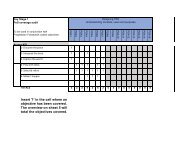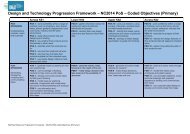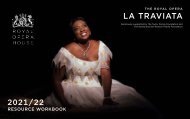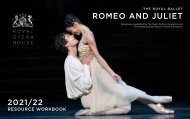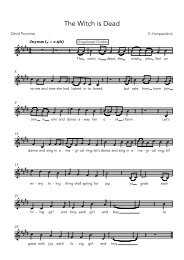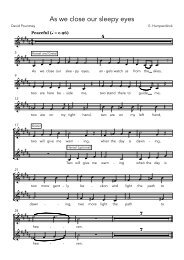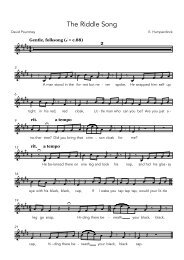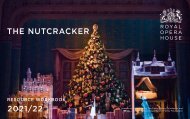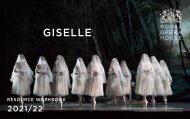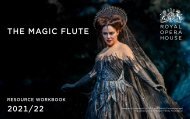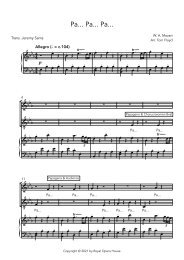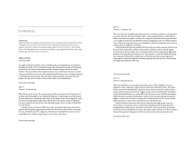Exploring La Fille mal Gardee
You also want an ePaper? Increase the reach of your titles
YUMPU automatically turns print PDFs into web optimized ePapers that Google loves.
<strong>Exploring</strong> Frederick Ashton’s <strong>La</strong> <strong>Fille</strong> <strong>mal</strong> gardée<br />
ACTIVITIES FOR KS2<br />
STUDENTS<br />
Frederick Ashton’s joyful<br />
ballet The Wayward<br />
Daughter features some<br />
of his most brilliant<br />
choreography.<br />
It is the story of Lise, the<br />
wayward daughter, who<br />
falls in love with a young<br />
farmer called Colas. Her<br />
mother, the widow Simone<br />
wants her to marry the<br />
daughter of a wealthy<br />
vineyard owner, whose<br />
name is Alais.<br />
We look forward to welcoming you and your<br />
class to the Royal Ballet’s production of Frederick<br />
Ashton’s <strong>La</strong> <strong>Fille</strong> <strong>mal</strong> gardée, one of the best loved<br />
in the Royal Ballet’s repertory.<br />
The exercises here are designed to introduce your<br />
class to the music, movement, choreographic ideas,<br />
and story of the ballet.<br />
If you record any of the creative responses of<br />
your students to the ballet, we would love to<br />
receive a copy. If you have any feedback on these<br />
resources, the production, or the Schools Matinees<br />
programme, please email us on<br />
schoolm@roh.org.uk.<br />
Enjoy the ballet!<br />
RESOURCES NEEDED FOR THESE ACTIVITIES<br />
©ROH 2015. Photograph by Tristram Kenton<br />
PAGE 1
ACTIVITY ONE: Introduction<br />
The ballet is set in a farmyard in an idealised version<br />
of the Suffolk Countryside. Choreographed by<br />
Frederick Ashton, it has been a favourite of the<br />
Royal Ballet since it was first performed in 1960.<br />
Relevant Curriculum Requirements<br />
Pupils should<br />
• use spoken language to develop<br />
understanding through speculating, hypothesising,<br />
imagining and exploring ideas<br />
• ask relevant questions to extend their<br />
understanding and knowledge<br />
• articulate and justify answers, arguments<br />
and opinions<br />
• give well-structured descriptions,<br />
explanations and narratives for different purposes,<br />
including for expressing feelings<br />
• use running and jumping in isolation and in<br />
combination<br />
• develop flexibility, strength, technique,<br />
control and balance<br />
• perform dances using a range of movement<br />
patterns<br />
• listen with attention to detail and recall<br />
sounds with increasing aural memory<br />
• appreciate and understand a wide range of<br />
high-quality live and recorded music drawn from<br />
different traditions and from great composers and<br />
Filmed Examples<br />
Chicken Dance<br />
https://www.youtube.com/watch?v=oAAodYX3xI8<br />
Rooster - Martin Milner, Chickens - Sinéad Bunn,<br />
Claudia Ortiz Arraiza, Jess Buckley, Joana Andrade,<br />
Bavarian State Ballet<br />
https://youtu.be/el4z9bJDO4o<br />
Natalia Osipova and Steven McRae in <strong>La</strong> <strong>Fille</strong> <strong>mal</strong><br />
gardée<br />
©ROH. Tristram Kenton, 2015. Frederick Ashton’s<br />
Royal Ballet production of <strong>La</strong> <strong>Fille</strong> <strong>mal</strong> gardée<br />
Describe how the ballet is set in a farmyard<br />
where there are all kinds of ani<strong>mal</strong>s (in fact a live<br />
pony comes onto the stage at one point!). There<br />
are chickens and a cockerel (or rooster) on the<br />
farm. Examine how chickens move - https://www.<br />
youtube.com/watch?v=bOizKdscvck. Or even<br />
better observe a real chicken if you can lay your<br />
hands on one!<br />
Make a list of words on the board about movements<br />
the students observe in the chickens.<br />
Divide the students into two groups – each person<br />
has a pair in the other group. Encourage the first<br />
group to travel around the room experimenting<br />
with different ways they can walk and can<br />
move their feet and arms in order to imitate the<br />
movements of a chicken. Encourage the other<br />
part of the pair to count the number of different<br />
movements their pair was able to achieve and<br />
assess their effectiveness.<br />
Encourage variety and consider these criteria:<br />
• How short/long are their strides?<br />
• How fast/slow can they move?<br />
• How easily can they change direction?<br />
• How far can they lift their feet?<br />
• What happens when they transfer weight from<br />
one foot to another or bend forward and back?<br />
• What happens when they add arm or head<br />
movements?<br />
• Swap groups and discuss the features each pair<br />
observed about their pair’s movement.<br />
• Discuss with the class what movements are<br />
most ‘chicken like’ and what body parts need to<br />
move.<br />
• Watch the youtube clip of the Chicken Dance<br />
from the ballet. Discuss how the movements<br />
were achieved and how effective they were.<br />
Particularly note the role of the rooster and how<br />
their movements are different.<br />
• Note the costumes and how they would have<br />
affected the movement.<br />
• Discuss with the students how comfortable the<br />
costumes would have been (they would have<br />
been very hot, and the mask/head gear would<br />
have made visibility difficult, and the sheer bulk<br />
PAGE 2
of the costume would limit ones movements).<br />
• Watch and listen to the dancers discuss what it<br />
is like to do the ‘Chicken Dance’ https://youtu.<br />
be/el4z9bJDO4o from 0:50-2:09<br />
• Discuss with the students how the music is<br />
appropriate for the dance (it is fast and staccato<br />
like, and the brass, winds and percussion<br />
instruments are prominent).<br />
• Devise your own ‘Chicken Dances’ in groups of<br />
4 (2 pairs). Use the movements devised earlier<br />
and refine them with additions from those<br />
observed in the ballet itself. Start by making a<br />
pattern of hops and turns and combining their<br />
paired movements into a group of four.<br />
• Perform for the rest of the class – encourage<br />
feedback.<br />
ACTIVITY TWO: Dancing a Ribbon<br />
Duet<br />
Along with the Clod Dance, the Ribbon Duet is one<br />
of the most iconic and symbolically rich moments<br />
in Ashton’s ballet.<br />
In pairs start at one side of the room and travel<br />
across the room. Students are to have contact or<br />
link with one part of the body of their partner at all<br />
times. Repeat several times finding different parts<br />
of the body to link with each time.<br />
Develop this idea by encouraging the students to<br />
create four ways of travelling across the space with<br />
their partner using the following words as stimulus:<br />
• Energetic<br />
• Athletic<br />
• Playful<br />
• Joyous<br />
In the same pairs, devise a 16-count sequence using<br />
the idea of linking parts of the body using the<br />
movements developed above. The sequence should<br />
include travelling movements and movements on<br />
the spot.<br />
Give each pair a piece of ribbon and encourage<br />
them to incorporate it into their routine. They could<br />
use it to indicate something – like riding a pony or<br />
Relevant Curriculum Requirements<br />
Pupils should<br />
• use running and jumping in isolation and in<br />
combination<br />
• develop flexibility, strength, technique, control<br />
and balance<br />
• perform dances using a range of movement<br />
patterns<br />
• use spoken language to develop understanding<br />
through speculating, hypothesising, imagining<br />
and exploring ideas<br />
Filmed Examples<br />
Ribbon Duet<br />
https://www.youtube.com/watch?v=H50e7FgcsQE<br />
Marianela Nuñez as Lise and Carlos Acosta as Colas<br />
in the Act I Pas de ruban from Frederick Ashton’s<br />
<strong>La</strong> fille <strong>mal</strong> gardée.<br />
Natalia Osipova and Steven McRae<br />
©ROH/Tristram Kenton, 2015<br />
PAGE 3
wrapping something up, or as a devise to join them<br />
to each other. Encourage them to use the ribbon<br />
to connect or weave their movements together<br />
and then undo the weaving or connection (as in a<br />
maypole dance).<br />
Have each pair demonstrate their ribbon duets<br />
to the class and discuss what they were trying to<br />
represent and how effective the weaving and and<br />
unweaving was visually.<br />
Watch the youtube clip of the Ribbon Duet<br />
performed by Lise and Colas from the Ballet.<br />
Discuss with the students how the duet explored/<br />
demonstrated the characteristics the students were<br />
using to devise their paired movements – Energetic,<br />
Athletic, Playful, Joyous.<br />
• Have students revise their own paired ribbon<br />
dance using some of the aspects of Lise and<br />
Colas’s dance.<br />
• Demonstrate to the class in turn and discuss<br />
how the dances changed or were influenced by<br />
watching the dance from the ballet.<br />
Extension<br />
Students attempt to do a cat’s cradle with a yard of<br />
string or wool tied in a loop. Refer to this youtube<br />
clip for instructions – the cats cradle itself can be<br />
found at 3:50:<br />
https://www.youtube.com/watch?v=CAZhx5PKgl4<br />
For those who are brave enough, encourage<br />
them to attempt a cat’s cradle with their ribbons.<br />
Remember that the ribbon needs to be tied in a<br />
circle and placed around their waists at some point.<br />
ACTIVITY THREE: Clog Dance<br />
Lise’s friends distract the widow Simone from Lise<br />
and Colas spending time together by getting her to<br />
dance with them. She performs a clog dance with<br />
them that is very comical but also quite technically<br />
difficult.<br />
Relevant Curriculum Requirements<br />
Pupils should<br />
• use running and jumping in isolation and in<br />
combination<br />
• develop flexibility, strength, technique, control<br />
and balance<br />
• perform dances using a range of movement<br />
patterns<br />
• use spoken language to develop understanding<br />
through speculating, hypothesising, imagining<br />
and exploring ideas<br />
Filmed Example<br />
Clog Dance<br />
https://www.youtube.com/watch?v=V5H4UMbKkgs<br />
LA FILLE MAL GARDÉE (Royal Ballet) Clog Dance,<br />
Widow Simone<br />
Ask the students if any can tap dance and if so<br />
have them demonstrate a few steps and teach<br />
them to the class if they are able. Discuss with the<br />
students how you have to wear special shoes to get<br />
the right sound and tap dancing is a complex and<br />
very technical style of dance.<br />
You might like to view this youtube clip of tap<br />
dancing to extend your students understanding -<br />
https://www.youtube.com/watch?v=LAU8eBek_NU<br />
Discuss with the students how the dancing itself<br />
provides a form of accompaniment and is often<br />
combined with other kind of body percussion –<br />
such as clapping hands, clicking fingers etc.<br />
In the ballet the widow Simone does a type of tapdance<br />
with some of Lise’s friends…but to add to the<br />
difficulty they are wearing clogs!<br />
Watch the youtube clip of the Clog Dance and<br />
discuss how difficult the movements they make<br />
would be in clogs and how they imitate dance<br />
movements like tap-dancing and dance on ‘points’<br />
in clogs. Note how the widow Simone’s movements<br />
PAGE 4<br />
Ludovic Ondiviella and Philip Mosley<br />
©ROH/Tristram Kenton, 2010
Marianela Nuñez and Carlos Actosta<br />
©ROH/Tristram Kenton, 2012<br />
are different from the other dancers (the widow,<br />
who is played by a man, does lots of ‘slapstick’ or<br />
clowning type of movements).<br />
Divide into groups of five and elect one person<br />
to play the more prominent role (such as widow<br />
Simone). Using any dance styles you are familiar<br />
with, (tap, contemporary, hip hop, folk dance)<br />
devise a 32-count movement sequence that<br />
includes unison movements for the four characters<br />
and something a little ‘extra’ for the main character.<br />
Rehearse and ensure the movements are clear,<br />
definite and together if unison occurs and how the<br />
solo role is made prominent.<br />
Perform for the class and score each group on<br />
these criteria.<br />
Note that this ballet has been performed many<br />
times by the Royal Opera House and the clogs<br />
worn by the company have been passed down<br />
from generation to generation of dancers (or<br />
‘cloggers’). They each have the dancers names<br />
written on the sole - https://www.youtube.com/<br />
watch?v=m1mJIA59qm4 9:12-11:45.<br />
Extension<br />
The Clog Dance is a type of folk dance and there<br />
are many folk dances used in this ballet. Another<br />
dance that is performed by the whole company is a<br />
Maypole Dance. This dance is danced to herald the<br />
arrival of spring and is still danced today by many<br />
people across the UK. More information can be<br />
found at this website https://en.wikipedia.org/wiki/<br />
Maypole<br />
Watch a video of a Maypole Dance being<br />
performed by a class of primary school students:<br />
https://www.youtube.com/watch?v=BtT21X4gKsM<br />
CWS 4th Grade does the Maypole Dance<br />
Discuss with the students how to perform a<br />
Maypole dance. This website may be helpful:<br />
http://www.maypoledance.com/maypoledance.html<br />
• Begin by standing in a circle and making a<br />
‘chain’ (weaving in between each other taking<br />
alternate hold of oncoming persons’ hand).<br />
• If you have enough ribbons for everyone you<br />
can make a series of maypoles where you<br />
attach the ribbons to a tall pole that is set in<br />
the ground or held by four children. Keep your<br />
dancers to groups of 12-16. Divide each group<br />
into two circles – one circle steps forward<br />
towards the pole and the outer circle dance<br />
around each person in turn.<br />
Watch and listen to the dancers discuss what it is<br />
like to do the ‘Maypole Dance’ https://youtu.be/<br />
el4z9bJDO4o from 2:09- 2.38.<br />
ACTIVITY FOUR: The Storm<br />
The Storm is a moment of descriptive, narrative<br />
musical writing in the ballet score.<br />
Relevant Curriculum Requirements<br />
Pupils should<br />
• use spoken language to develop understanding<br />
through speculating, hypothesising, imagining<br />
and exploring ideas<br />
• play and perform in solo and ensemble<br />
contexts, using their voices and playing musical<br />
instruments with increasing accuracy, fluency,<br />
control and expression<br />
• listen with attention to detail and recall sounds<br />
with increasing aural memory<br />
• appreciate and understand a wide range of<br />
high-quality live and recorded music drawn<br />
from different traditions and from great<br />
composers and musicians<br />
Audio Example<br />
https://www.youtube.com/watch?v=qTs374j1Sb4<br />
Ballet Joelen<br />
Discuss the way sounds can be made to tell a story.<br />
PAGE 5
Imagine the sound of a rainstorm starting softly and<br />
building in intensity.<br />
Discuss the sounds heard when it first starts to rain.<br />
Are the sounds regular or more random?<br />
“How can you make these sounds with your body?”<br />
(clicking, gentle tapping, clicking your tongue etc.).<br />
Focus on random sound creation, without regularity<br />
and beat.<br />
“How can these sounds be made with instruments<br />
and sound sources in the room?” (tapping sticks<br />
gently, crackling paper, dropping pebbles on the<br />
ground etc)<br />
Discuss the way the sounds change as the rain gets<br />
heavier (louder, heavier, stronger, more regular, one<br />
sound rather than individual drops). Discuss and<br />
explore sound possibilities.<br />
Divide into groups and using vocal sounds, available<br />
instruments and found sound sources encourage<br />
each group to devise their own storm. Ask them to<br />
consider how the storm is structured. Does it begin<br />
quickly or build in intensity? Does it finish softly or<br />
abruptly? Is there lightning? Thunder? Wind? Rain?<br />
Perform the storms for each other and discuss their<br />
structure.<br />
At the end of Act II, a violent storm breaks out<br />
accompanied musically in the ballet by a borrowing<br />
of the storm music from Rossini’s opera Cinderella.<br />
We hear the wind begin to moan (low strings) as<br />
dark, black clouds scud threateningly across the<br />
sky, followed quickly by a brief flicker of lightning<br />
(flute), the first few drops of rain (harp), and a<br />
distant but growing roll of thunder (timpani) until<br />
the full fury of the storm is suddenly unleashed<br />
in the entire orchestra and torrential rain (upper<br />
strings) is lashed about at gale force. In the middle<br />
section, there is a period of calm where the storm<br />
appears to have eased off and the woodwind<br />
instruments take it in turn to play, as though<br />
imitating the birds beginning to sing again. The<br />
storm renews its attack however, and the act ends<br />
with Alain transported through the air on his red<br />
umbrella (Swanee whistle).<br />
Listen to the storm and compare it with the class<br />
storms. Note Rossini’s storm has a ‘quieter’ section<br />
in the middle where Lise and Colas meet. Would<br />
this be ‘the eye of the storm’?<br />
Compare the classes’ storms with Rossini’s. Choose<br />
a class composition you think is most effective.<br />
Choreograph a dance to accompany this<br />
composition. Include fast movements travelling<br />
forwards and backwards as though being buffeted<br />
by the wind, turning on yourself and in groups,<br />
and leaps and turns, which are repeated by larger<br />
numbers of people. Try to give a sense of chaos.<br />
ACTIVITY FIVE: The Overall Picture<br />
Frederick Ashton’s final full-length ballet is one of<br />
his most joyous creations, imbued with his love for<br />
the Suffolk countryside.<br />
Relevant Curriculum Requirements<br />
Pupils should<br />
• use spoken language to develop understanding<br />
through speculating, hypothesising, imagining<br />
and exploring ideas<br />
• ask relevant questions to extend their<br />
understanding and knowledge<br />
• listen with attention to detail and recall sounds<br />
with increasing aural memory<br />
• appreciate and understand a wide range of<br />
high-quality live and recorded music and ballet<br />
drawn from different traditions and from great<br />
dancers and musicians<br />
• develop an understanding of the history of<br />
music and ballet.<br />
©ROH/Tristram Kenton, 2010<br />
PAGE 6
Steven McRae<br />
©ROH/Tristram Kenton, 2015<br />
Filmed Examples<br />
Background on the ballet with examples:<br />
https://youtu.be/el4z9bJDO4o<br />
Natalia Osipova and Steven McRae in <strong>La</strong> <strong>Fille</strong> <strong>mal</strong><br />
gardée ©ROH. Tristram Kenton, 2015. Frederick<br />
Ashton’s Royal Ballet production of <strong>La</strong> <strong>Fille</strong> <strong>mal</strong><br />
gardée<br />
https://www.youtube.com/watch?v=m1mJIA59qm4<br />
The Royal Opera House have made two short films<br />
about the making and staging of the ballet. They<br />
are both worth watching as a way of setting the<br />
scene.<br />
Note how they use a live Shetland pony on stage.<br />
Discuss how easy this would be to manage at the<br />
Opera House.<br />
Discuss with the students how Frederick Ashton<br />
has located the ballet in the English countryside<br />
and how he achieves this (the painted set, the<br />
costumes, the folk dances, the ani<strong>mal</strong>s).<br />
Discuss how realistic the happy ending is to the<br />
ballet.<br />
Ask the students to predict which will be the most<br />
varied dance, the most difficult dance, and the<br />
dance they are looking forward to seeing the most.<br />
Have the students note their predictions and put<br />
them in a sealed envelope.<br />
When they return from the performance have them<br />
compare their predictions with their real experience.<br />
PAGE 7





